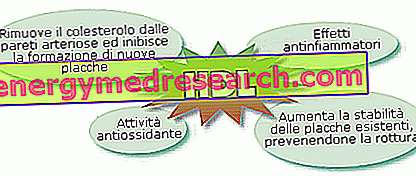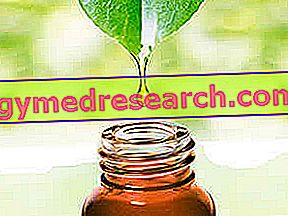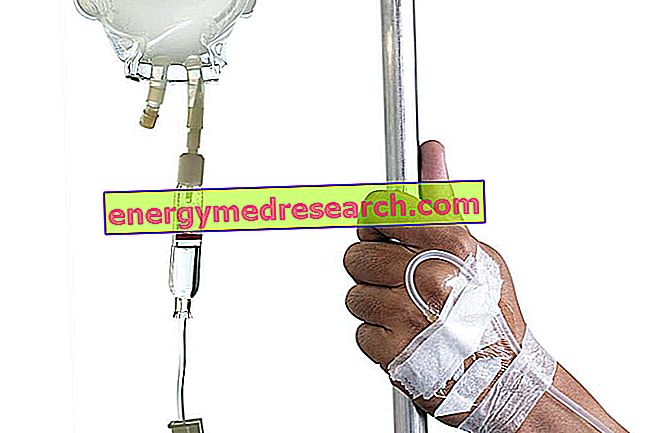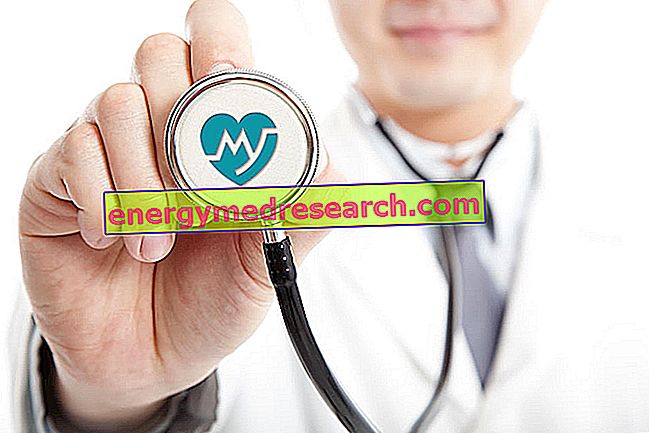Generality
Cholesterol associated with so-called high density lipoprotein or HDL (High Density Lipoprotein) is considered "good". The reason is simple: instead of accumulating in the blood like the "bad" (LDL), the fraction of HDL cholesterol travels to the liver to be properly disposed of.
To protect cardiovascular health, HDL blood levels should be equal to or greater than 50 mg / dl.
Importance of HDL Cholesterol

By simplifying the topic as much as possible, we can compare HDL cholesterol to a sort of scavenger; at peripheral level, in fact, HDL prevents the deposition of cholesterol in the arteries, incorporating it and transporting it to the liver, where it is metabolized and excreted with bile.
Having ascertained all this, the question arises:
Is there a way to increase HDL cholesterol?
The answer is positive, indeed, to be honest, there are really many ways that can lead to an increase in HDL cholesterol levels.
The effectiveness of the interventions that we are going to analyze has emerged in the course of numerous studies, which must however be read carefully between the lines to avoid giving in to easy enthusiasms.
What's this
HDL cholesterol is the fraction of cholesterol that is associated with high density lipoproteins (High Density Lipoprotein).
What are lipoproteins
Lipoproteins are molecular structures that we can compare to "ships" loaded with cholesterol and other fats. These particles are made up of a lipid core, wrapped in a shell of proteins.
To reach the various tissues, cholesterol is enclosed in lipoproteins.
The function of high-density lipoproteins consists in collecting the excess cholesterol present in the bloodstream and bringing it back to the liver, so that it is eliminated. In practice, high-density lipoproteins cleanse blood from unused cholesterol, limiting its accumulation on the vessel wall and reducing the risk to the heart and arteries; for this reason, HDLs are called "good" cholesterol.

If blood tests show high values of this parameter, it is a good sign, since HDL cholesterol plays a protective role against problems such as atherosclerosis, stroke and heart attack.
Why do you measure
Blood HDL cholesterol levels are measured to assess the risk of developing a cardiovascular disease .
In fact, several scientific studies have identified a link between specific “threshold” values of this parameter and the probability of manifesting atherosclerosis and / or diseases of the circulatory system, including stroke and heart attack. The ratio between total cholesterol and HDL is above all suitable for this purpose, which makes it possible to consider the quantity of "good" cholesterol, compared to the total cholesterol present in the blood.
The examination also allows the monitoring of the patient during hypocholesterolizing therapy and in diet regimes.
Normal values
HDL cholesterol has an ideal value equal to or greater than 50 mg / dl of blood: the more it is in circulation, the more the probability of developing circulatory disorders is reduced.
To assess the risk of cardiovascular events that a person runs, it is also necessary to consider the relationship between the value of total cholesterol and that of HDL. The number obtained should be less than 5 for the man and 4.5 for the woman.
HDL cholesterol: reference values | |
<50 mg / dl | Too short |
50 - 59 mg / dl | Good |
≥ 60 mg / dl | Great |
HDL High - Causes
An increase in HDL cholesterol is generally considered positive.
FACTORS INCREASING HDL CHOLESTEROL
- Weight loss / reaching and maintaining a healthy weight;
- Regular aerobic physical activity (5 times a week, for thirty minutes a day);
- Alcohol (moderate consumption);
- Diet rich in monounsaturated and omega-three fatty acids;
- Lauric acid;
- Female sex during childbearing age.

The graph shows a clear relationship between an increase in HDL cholesterol values and a reduction in cardiovascular risk
DRUGS THAT INCREASE HDL CHOLESTEROL
- fibrates;
- Niacin;
- Estrogen;
- Statins;
- cholestyramine;
- Fish oil;
- Phenytoin / carbamazepine;
- Insulin.
DISEASES THAT INCREASE HDL CHOLESTEROL
An increase in serum HDL cholesterol may be associated with a number of pathological conditions, such as:
- Family or secondary hyperlipoproteinemia;
- Primary biliary cirrhosis;
- Chronic hepatitis;
- Chronic intoxications.
HDL Low - Causes
FACTORS DECREASING HDL CHOLESTEROL
- Obesity;
- sedentary lifestyle;
- Cigarette smoke;
- Diet rich in carbohydrates;
- Menopause;
- Diet rich in trans fatty acids;
- Insuluno-resistance;
- Male sex.
DRUGS THAT DECREASE HDL CHOLESTEROL
- Androgens;
- progestin;
- Beta blockers;
- Thiazide diuretics;
- Nicotine;
- probucol;
- Anti-retroviral drugs;
- Retinoic acid.
DISEASES THAT DECREASE HDL CHOLESTEROL
An increase in the total serum cholesterol concentration is normally (but not necessarily) associated with a relative decrease (percentage) of HDL cholesterol.
A low serum HDL cholesterol may depend on various pathological conditions, including:
- Ipolipoproteinemie;
- Decompensated diabetes;
- Hepatocellular disorders;
- cholestasis;
- Nephrotic syndrome;
- Chronic renal failure.
Even an increase in triglyceride values can cause a decrease in HDL cholesterol.
How to measure it
To measure the total cholesterol level, HDL and LDL, as well as the total cholesterol / HDL ratio, it is sufficient to undergo a simple blood test.
Preparation
All the tests for the evaluation of the lipid profile are performed after a fast of 9-12 hours, during which a small quantity of water is allowed.
In the days leading up to the withdrawal, it is important to keep your lifestyle as habitual as possible and not to vary the diet.
Possible interventions
In the event that the results of the examination are different from the reference values, the doctor will know how to assess the associated cardiovascular risk and indicate the most targeted intervention.
Adopting a balanced diet (limiting animal fats and eating lots of fruit and vegetables), and practicing regular physical activity, are the best way to increase the amount of "good" cholesterol in the body.
In addition to these habits, if necessary, the doctor can also indicate the addition of a targeted pharmacological remedy.
Increase HDL without drugs
| STRATEGY | EXPECTED RESULT | NOTE |
| Physical activity | Increased HDL cholesterol from 3 to 9%; | This increase was recorded in the transition from a sedentary lifestyle to regular exercise. The increase in expected HDL cholesterol is therefore lower, if not zero, for people who are already active. To learn more: physical activity and cholesterol. |
| Abolition of smoking | Increased HDL cholesterol of 4 mg / dl | The increase seems more consistent in women than in men and in people with already high HDL values (> 47 mg / dL). To learn more: smoke damage. |
| Body weight reduction | Increased HDL cholesterol by 0.35 mg per kg of weight lost, if overweight or obese | The positive effect on HDL cholesterol values is recorded only if the weight reached is maintained over time; the pounds lost with so-called yo-yo diets do not seem to have this effect. In fact, during weight loss there are no increases, but slight declines in HDL cholesterol. |
| Slight alcohol consumption | Increased HDL cholesterol of 4 mg / dl | The positive effect is noticeable only for a moderate consumption of alcohol (about 30 g / day); it is not clear whether this effect is sufficient to recommend a regular and moderate consumption of alcohol or if the risks of this practice exceed the real benefits. |
| Diet | If you adopt a low-calorie diet, or if you switch from a high-calorie diet to a normocaloric diet, HDL cholesterol levels tend to decrease in step with those of LDL and total cholesterol, which decrease especially if you switch from excess fat animals (saturated) due to their partial substitution with vegetable oils (except palm oil and partially hydrogenated ones). There does not appear to be "magic" foods capable of increasing HDL cholesterol; the omega-three associated with a low glycemic load diet may be helpful in this regard. | |
Increase HDL with drugs
| DRUG | EXPECTED RESULT | Side effects; for contraindications consult the in-depth articles by clicking on the name of the drug |
| Niacin | Increased HDL cholesterol by 20-35%. LDL decrease of 5-25%. Triglyceride reduction of 20-50%. | Common side effects: itching, hot flushes (attenuated in controlled release preparations), dyspepsia, hypotension, abdominal pain, increased LDH levels, hyperuricemia, increased liver transaminases, increased liver function. Serious side effects: hepatotoxicity, arrhythmias, severe hypotension, bleeding |
| fibrates | Increased HDL cholesterol by 10-25%. LDL decrease of 5-20%. Triglyceride reduction of 20-50%. | Common side effects: increased liver transaminases, increased liver function, abdominal pain, increased creatine kinase levels, nausea, respiratory disorders, back pain, headache, constipation, rhinitis. Serious side effects: myopathies, cholestasis, myositis, hepatitis, pancreatitis. |
| Statins | Increased HDL cholesterol by 5-15%. LDL drop of 15-55%. Triglyceride reduction of 7-30%. | Common side effects: myalgia, increased creatine kinase levels: increased liver transaminases, dyspepsia, abdominal pain, diarrhea, nausea, headache, back pain, flu-like syndromes, urinary tract infections, rhinitis or sinusitis, constipation, atralgia or arthritis, rush, paresthesia, peripheral edema, pharyngitis, asthenia. Serious side effects: myopathies, hepatotoxicity, pancreatitis, angioedema, leukopenia, thrombocytopenia, rush vesiculobullous, photosensitivity, rhabdomyolysis. |



